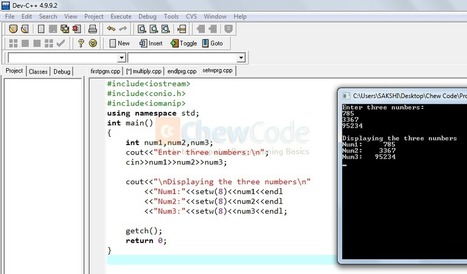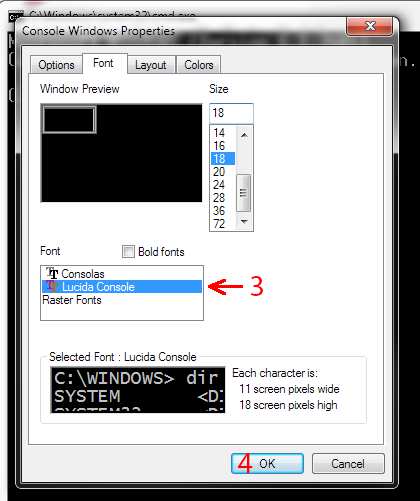How To Use Setw In Dev C++
How to use Dev-C Introduction Dev-C is a full-featured integrated development environment (IDE), which is able to create Windows or DOS-based C/C programs using the Mingw compiler system (included with the package), or the Cygwin compiler. These are the recommended requirements of Dev-C: Microsoft Windows 98, NT or 2000 32 MB RAM. C iomanip Library - setw Function - The C function std::setw behaves as if member width were called with n as argument on the stream on which it is inserted/extracted as a manipulator (it can b. Jul 08, 2018 code iomanip /codeis used to set up certain format parameters, so the question can actually mean two things: 1. Why do we set format parameters 2. We use iomanip istead of simple functions. Std::setw: Set field width; Sets the field width to be used on output operations. Behaves as if member width were called with n as argument on the stream on which it is inserted/extracted as a manipulator (it can be inserted/extracted on input streams or output streams).
Jan 11, 2012 Using cout.width and flags to control the width and alignment of items output to the console in C. When writing output in C,you can use either std::endl or 'n' to produce a newline, but each has a different effect. Std::endl sends a newline character 'n' and flushes the output buffer. 'n' sends the newline character, but does not flush the output buffer. The C function std::setprecision behaves as if member precision were called with n as argument on the stream on which it is inserted/extracted as a manipulator (it can be inserted/extracted on input streams or output streams). It is used to sets the decimal precision to be used to format floating.
Free vst plugins software download windows 7. Manipulators are operators used in C++ for formatting output. The data is manipulated by the programmer's choice of display.

Some of the more commonly used manipulators are given below:
endl Manipulator
endl is the line feed operator in C++. It acts as a stream manipulator whose purpose is to feed the whole line and then point the cursor to the beginning of the next line. We can use n (n is an escape sequence) instead of endl for the same purpose.
setw Manipulator
This manipulator sets the minimum field width on output.
Example:
setfill Manipulator
This is used by the setw manipulator. If a value does not entirely fill a field, then the character specified in the setfill argument of the manipulator is used for filling the fields.
Creating cleanly formatted output is a common programming requirement--itimproves your user interface and makes it easier to read any debuggingmessages that you might print to the screen. In C, formatted output works viathe printf statement, but in C++, you can create nicely formatted output tostreams such as cout. This tutorial covers a set of basic I/O manipulationspossible in C++ from the iomanip header file. Note that all of the functionsin the iomanip header are inside the std namespace, soyou will need to either prefix your calls with 'std::' or put 'using namespacestd;' before using the functions.

Dealing with Spacing Issues using iomanip
A principle aspect of nicely formatted output is that the spacing looks right.There aren't columns of text that are too long or too short, and everything isappropriately aligned. This section deals with ways of spacing outputcorrectly.Setting the field width with setw
The std::setw function allows you to set the minimum width of the next outputvia the insertion operator. setw takes, one argument, the width of the nextoutput (insertion), an integer. if the next output is too short, then spaceswill be used for padding. There is no effect if the output is longer than thewidth--note that the output won't be truncated. The only strange thing aboutsetw is that its return value must be inserted into the stream. The setwfunction has no effect if it is called without reference to a stream.A simple example isThe output from the above would look like this:Note that since setw takes an argument, at runtime it would be possible tospecify the width of a column of output so that it is slightly wider than thelongest element of the column.You might wonder whether it is possible to change the padding character. Itturns out that yes, you can, by using the setfill function, which takes acharacter to use for the padding. Note that setfill should also be used as astream manipulator only, so it must be inserted into the stream:The above code sets the padding character to a dash, the width of the nextoutput to be at least 80 characters, and then outputs a dash. This results inthe rest of the line being filled with dashes too. The output would look likethis:Note that the pad character is changed until the next time you call setfill tochange it again.
Aligning text with iomanip
It's possible to specify whether output is left or right aligned by using themanipulator flags that are part of ios_bas. In particular, it is possible tospecify that output should be either left or right aligned by passing inthe stream manipulators std::left and std::right.Putting Your Knowledge of iomanip Together
Now that we know how to space and align text, we can correctly print formatteddata in columns. For instance, if you had a struct containing the names ofindividuals:If you then had a vector of persons, then you could output them in a nice waywith evenly spaced columns for the first and last name as follows:Note that the space output between the two fields wasn't strictly necessarybecause we could have added it by changing the first call to setw to set thewidth to one more than the longest first name (since it would use a space asthe padding for the extra character).Printing Numbers
Another challenge in creating nice output is correctly formatting numbers; forinstance, when printing out a hexadecimal value, it would be nice if it werepreceded by the '0x' prefix. More generally, it's nice to correctly set thenumber of trailing zeros after a decimal place.Setting the precision of numerical output with setprecision
The setprecision function can be used to set the maximum number of digits thatare displayed for a number. Like setw, it should be inserted into the stream.In fact, its usage is very similar to setw in all respects. For instance, toprint the number 2.71828 to 3 decimal places:Note that setprecision will change the precision until the next time it ispassed into a given stream. So changing the above example to also print out1.412 would result in the output ofOutput in different bases
In computer science, frequently numbers need to be printed in octal orhexadecimal. The setbase function returns a value that can be passed into astream to set the base of numbers to either base 8, 10, or 16. The inputnumber is still read as a number in base ten, but it is printed in the givenbase. For instance, will print out '20', which is 32 written in base 16. Note that you can usedec, oct, and hex as shorthand for setbase(10), setbase(8), and setbase(16)respectively when inserting into a stream. If you wish to include an indication of the base along with the printednumber, you can use the setiosflags function, again passed into a stream, withan input of ios_base::showbase.Using the ios_base::showbase flag will append a '0x' in front of hexadecimalnumbers and a 0 in front of octal numbers. Decimal numbers will be printed asnormal.This should get you started with the ability to create nicely formatted outputin C++ without having to resort to returning to printf!How To Use Setw In Dev C Language
RelatedLearn to interpret and use sophisticated printf format strings